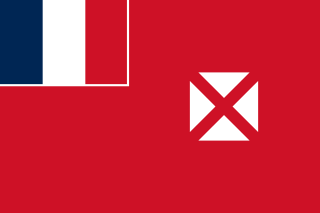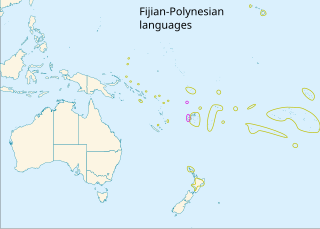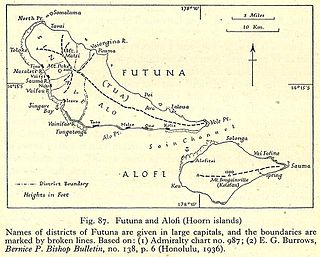
Wallis and Futuna, officially the Territory of the Wallis and Futuna Islands, is a French island collectivity in the South Pacific, situated between Tuvalu to the northwest, Fiji to the southwest, Tonga to the southeast, Samoa to the east, and Tokelau to the northeast.

The Polynesian languages form a genealogical group of languages, itself part of the Oceanic branch of the Austronesian family.

The official flag of Wallis and Futuna is the French national flag, as it is a French territory. Wallis and Futuna has a locally used unofficial flag which bears the French flag in the canton.

Futuna is the largest island in Hoorn Islands or Îles Horne, located in the Pacific Ocean, part of the French overseas collectivity of Wallis and Futuna. The island occupies an area of 80 km2 (30 sq mi) and as of 2018 it has a population of 10,912.

Politics of Wallis and Futuna takes place in a framework of a parliamentary representative democratic French overseas collectivity, whereby the President of the Territorial Assembly is the head of government, and of a multi-party system. Executive power is exercised by the government.

Wallis is a Polynesian atoll/island in the Pacific Ocean belonging to the French overseas collectivity of Wallis and Futuna. It lies north of Tonga, northeast of Fiji, east-northeast of the Hoorn Islands, east of Fiji's Rotuma, southeast of Tuvalu, southwest of Tokelau and west of Samoa. Its area is almost 100 km2 (39 sq mi) with 8,333 people. Its capital is Mata Utu. Roman Catholicism is the predominant religion. Its highest point is Mount Lulu Fakahega. Wallis is of volcanic origin with fertile soil and some remaining lakes. Rainfall is plentiful.

Mata Utu is the capital city of Wallis and Futuna, an overseas collectivity of France. It is located on the island of Uvéa (ʻUvea), in the district of Hahake, of which it is also the capital. It is one of two ports in Wallis and Futuna, the other being at Leava on Futuna. Hihifo Airport, the main airport serving the island and city, is 5.6 kilometres (3.5 mi) to the northwest. Its population was 1,029 in 2018, up from 815 in 1998.
The galleries below show flags attributed to the eighteen regions, five overseas collectivities, one sui generis collectivity and one overseas territory of France. Most of them are both non-official and traditional as regions often use their logos as a flag though some regions used the banner ol flags.

The Territorial Assembly of Wallis and Futuna is the legislature of Wallis and Futuna. It consists of 20 members, elected for a five-year term by proportional representation in multi-seat constituencies. The Assembly sits in Mata Utu, the capital of the territory.
Tu'i, also spelled more simplistically Tui, is a Polynesian traditional title for tribal chiefs or princes. In translations, the highest such positions are often rendered as "king". For details, see the links below various polities. Traditionally, a Tui is an equivalent of God title. Origin of Tui is believed to be Tui Manu'a.
Wallisian, or ʻUvean, is the Polynesian language spoken on Wallis Island. The language is also known as East Uvean to distinguish it from the related West Uvean language spoken on the outlier island of Ouvéa near New Caledonia. The latter island was colonised from Wallis Island in the 18th century.
Futunan or Futunian is the Polynesian language spoken on Futuna. The term East-Futunan is also used to distinguish it from the related West Futunan (Futuna-Aniwan) spoken on the outlier islands of Futuna and Aniwa in Vanuatu.

The following outline is provided as an overview of and topical guide to Wallis and Futuna:
Kapeliele "Gabriel" Faupala was the 51st Lavelua (King) of Wallis Island (Uvea), one of the three traditional kingdoms which comprise the French overseas territory of Wallis and Futuna. Faupala was officially crowned Lavelua on July 25, 2008, succeeding Tomasi Kulimoetoke II, who died in May 2007. He was removed from office in September 2014.
Petelo Vikena was Tuigaifo, or Monarch, of the Kingdom of Alo, which is also known as the Kingdom of Futuna from his coronation on November 6, 2008 to his abdication on January 22, 2010. Alo is one of the three traditional kingdoms, or chiefdoms, which comprise Wallis and Futuna.

ʻUvea is one of the three official chiefdoms of the French territory of Wallis and Futuna in Oceania in the South Pacific Ocean.
Susitino Sionepoe, S.M. is a Futunan Catholic prelate and the current Bishop of Wallis et Futuna. He was consecrated on March 24, 2019, by Archbishop Michel-Marie-Bernard Calvet in Mata'Utu, the Capital of Wallis and Futuna. His appointment as bishop was the result of the resignation of the previous bishop on 24 December 2018. He is a member of the Marists.

The kātoaga is a customary festival in Wallis and Futuna, a French overseas collectivity in Oceania with a Polynesian culture. During this ceremony, goods are exchanged, such as pigs, baskets of vegetables, banigs, tapa or envelopes filled with banknotes. It takes place on the occasion of religious festivals, political events or private events. Of ancient origin and present in many Polynesian societies, the katoaga obeys a strict ritual and protocol that has changed little since the Christianization of Wallis and Futuna in the 19th century. It begins with a Catholic mass, is followed by a meal, a kava ceremony and dances performed by the villagers, before the food brought by the inhabitants is redistributed to the dignitaries and the population, each gift being allocated according to the rank of the person for whom it is intended. Speeches, poems and stories from the oral tradition are recited by the participating dignitaries. These major customary celebrations mobilize several villages or districts, and require several weeks or even months of preparation.
The Second World War in Wallis and Futuna was a period of significant upheaval for this French protectorate territory in the Pacific.














